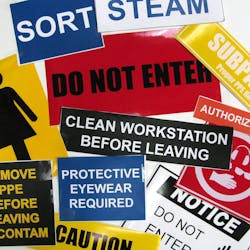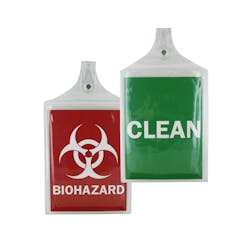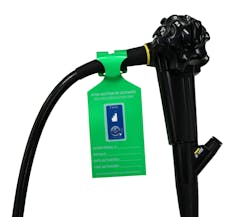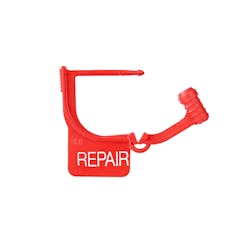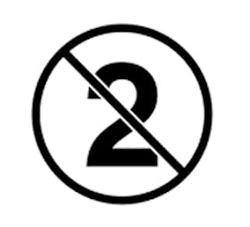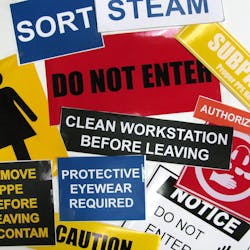Q: “Are we required to have hangtime or expiration labels on our flexible scopes? What about labeling for dirty transport?”
A:
To answer your specific question about hangtime, here is a section from ANSI/AAMI ST91:20211 – 11.2.3 – Identification of endoscopes during storage.1a
“Protocols should be developed to help ensure that users can readily identify an endoscope that has been processed and is ready for patient use.”
Further, it states, “Before it is placed in the storage cabinet, a label or tag should be attached to the processed endoscope that includes:
- The processing date;
- The name(s) of the person(s) who performed the processing, optionally as specified by facility policy; and
- The expiration date, based on facility’s established risk assessment, if applicable.”1a
The facility must establish a policy for hangtime based on a risk assessment of their inventory, or, if they are following or referencing SGNA standards in their policies or procedures, SGNA recommends no longer than a 7-day hangtime.2
And for dirty transport, also from ANSI/AAMI ST91:2021 – 7.3.2 – Procedure:1b
“Each endoscope should be isolated and transported with its components in a closed container or closed transport cart to the next stage of processing, as it is considered contaminated. The transport cart or container must be labeled with a fluorescent orange, orange-red, or red label containing a biohazard legend and must meet OSHA requirements (29 CER 1910.1030)3 for transporting hazardous items. The closed container or closed transport cart must be non-porous, leak-proof on its side and bottom, puncture-resistant, and large enough to accommodate a single endoscope without the need to over-coil the insertion or light guide tubes. When endoscopes are transported on cart tops, a bag with an affixed biohazard label and designed for containment and transportation of soiled endoscopes may be used.”1b
Later in that section, “Hand-off communication from the transporter to the processing location should include:
- Confirmation that the endoscope was transported correctly, and all accessory parts are present;
- The date and time of completion of use of that device;
- The time of point of use treatment; and
- Patient identifier.”
The rationale for why all this information is required for soiled transport is because the time between point-of-use and decontamination is vitally important. If there is a delay of more than 60 minutes between point-of-use treatment (POUT) and manual decontamination steps, it can trigger “delayed reprocessing” steps found in most flexible scope IFUs. These delayed reprocessing steps can be time-consuming, with extended soak times and additional steps adding to the cleaning process. Surveyors are scrutinizing communication steps between point-of-use and reprocessing steps (and there is plenty of must have information), so make sure your facility has a good, easy-to-explain process of how that communication is taking place.
This leads me to another major point that should be mentioned: Visual communication is key.
Visual communication is the use of visual elements like images, designs, and graphics to convey messages and information. (canva.com)4 Think about that biohazard symbol ☣. The fluorescent orange, orange-red, or red label containing the biohazard symbol (Fig. 1) gives the handler information about the contents without any verbal communication.
A good visual communication labeling system conveys vital information easily with low probability of misinterpretation/miscommunication. For hang-time labeling, I’ve seen some departments make the mistake of having confusing or conflicting information on their labeling.
The processing date alone written on the label could lead someone to misunderstand the label and assume it is already expired. I once visited a facility that wrote both the processing date and the expiration (use-by) date on the label, causing confusion with the endoscopy staff.
This is where utilizing visual communication labels (e.g., Fig. 2) on the market can give a visual indication of whether a scope has passed its hangtime (per facility policy).
Another aspect to consider is how scopes are labeled as damaged or in need of repair. Trust me when I say that for an endoscopist, there aren’t many more frustrating experiences than starting to use an endoscope only to realize that the endoscope is damaged. In addition to hangtime and used endoscope labeling, ANSI/AAMI ST91:2021 – 7.8 – Inspection and cleaning verification1c also speaks to the need to label scopes in need of repair:
“Defective endoscopes, accessories, and equipment should be removed from service and repaired or replaced. (AORN, 2018)7 A label should be affixed to the device to identify defective equipment for repair.” (Fig. 3).
The repair process and communication between the point-of-use and reprocessing staff is another area of frequent communication breakdown. Communication must be clear when it comes to a defective scope—even if there is no verbal communication between the departments.
There are too many examples of the importance of visual communication in the healthcare environment to list them all, but here are some other notable examples:
- Areas that are labeled “Do not enter,” such as the decontamination area.
- The ISO symbol (the number 2 encompassed in a circle with a diagonal line slashing from the top left to bottom right [Fig. 4]) means “do not reuse,” typically seen on single-use surgical instrumentation.
Visual communication is an everyday part of the healthcare environment, and clear, easy-to-understand communication (e.g., Fig. 5) is a vital component for effective reprocessing.
References (APA Style 7th Edition):
-
AAMI (2021). ANSI/AAMI ST91:2021 Flexible and semi-rigid endoscope processing in health care facilities [PDF]. Arlington, VA: Association for the Advancement of Medical Instrumentation.
-
11.2.3 – Identification of endoscopes during storage.
-
7.3.2 – Procedure.
-
7.8 – Inspection and cleaning verification.
-
-
SGNA. (2018). Standards of Infection Prevention in Reprocessing Flexible Gastrointestinal Endoscopes [PDF]. Chicago, IL: Society of Gastroenterology Nurses and Associates.
-
OSHA/Dept of Labor Occupational Safety and Health Administration. Code of Federal Regulations: Occupational Exposure to Bloodborne Pathogens. Title 29 [Bloodborne pathogens], Standard No. 1910.1030. United States Dept of Labor/OSHA. https://www.osha.gov/laws-regs/regulations/standardnumber/1910/1910.1030
-
Canva. (2025). What is visual communication. Canva. https://www.canva.com/learn/visual-communication/
-
Healthmark. (2020, August). Clean/Dirty Reversible Signs [image]. Healthmark, A Getinge company. https://www.hmark.com/product/clean-and-dirty-reversible-signs/
-
Healthmark. (2020, August). 7 Day Indicator Hangtime Label [image]. Healthmark, A Getinge company. https://www.hmark.com/product/7-day-indicator-hangtime-label/
-
AORN. (2018). Guidelines for Perioperative Practice, Guideline for instrument cleaning; 436-438 [PDF]. The Association of periOperative Registered Nurses. Denver, CO.
-
Healthmark. (2020, August). Instrument Repair Tags (Red) [image]. Healthmark, A Getinge company. https://www.hmark.com/product/instrument-repair-tags/
-
International Organization for Standardization. (2004). ISO 7000 — Graphical symbols for use on equipment—Registered symbols Graphical symbols for use on equipment Registered symbols (ISO 7000-1051). ISO. https://www.iso.org/obp/ui/#iso:grs:7000:1051
-
Healthmark. (2020, August). Custom Vinyl Labels [image]. Healthmark, A Getinge company. https://www.hmark.com/product/custom-vinyl-labels/
About the Author

Adam Okada
Clinical Education Specialist, Healthmark, a Getinge company
Adam Okada has 18+ years of experience in Sterile Processing and is passionate about helping improve the quality of patient care by giving SPD professionals and their partners greater access to education and information. He has worked in just about every position in the Sterile Processing Department, including Case Cart Builder, SPD Tech I, II, and III, Lead Tech, Tracking System Analyst, Supervisor of both SPD and HLD, Manager, and now as an Educator. Adam is the owner of Sterile Education, the world’s first mobile application dedicated to sterile processing education, and a former Clinical Manager at Beyond Clean. He has published articles for HSPA’s Process magazine, is a co-chair on AAMI WG45 as well as co-project manager for the KiiP “Last 100 Yards” group, and is the former President for the Central California Chapter of HSPA. Adam is currently a Clinical Education Specialist at Healthmark, A Getinge company, where he works on Healthmark webinars, hybrid events, and educational videos, as well as the "Ask the Educator" Podcast with Kevin Anderson.
